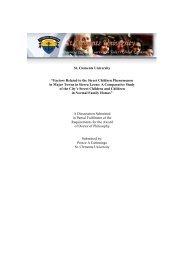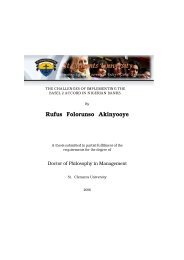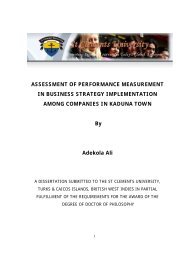CHURCH AWARENESS AND PRACTICE OF TOTAL QUALITY ...
CHURCH AWARENESS AND PRACTICE OF TOTAL QUALITY ...
CHURCH AWARENESS AND PRACTICE OF TOTAL QUALITY ...
You also want an ePaper? Increase the reach of your titles
YUMPU automatically turns print PDFs into web optimized ePapers that Google loves.
3.3 Data Analysis Method: The objectives and the nature of this study demand that<br />
Frequency Percentages be adopted and used to statistically analyze the findings. This<br />
approach we believe will give good level of accuracy of judgments - considering the fact<br />
that the universe was aptly represented, the sample well covered and the respondents well<br />
spread.<br />
CHAPTER FOUR<br />
4. Data Presentation and Analysis: Data are presented and analyzed in the following<br />
order.<br />
4.1 General Data Overview<br />
4.2 Testing the hypotheses in relation to the questionnaires.<br />
4.3 Assessing the methods of implementation employed by Church organizations that<br />
have implemented TQM in Nigeria.<br />
4.4 Assessing the success levels after implementation.<br />
4.5 Pin-pointing the reasons for success.<br />
4.6 Assessing the practice climate in relation to success.<br />
4.7 Presentation of all Data Tables in General.<br />
Sticking to points stated above with a complete focus on the realization of the objectives<br />
of this research, the data presentation, analysis, discussions and conclusions will focus<br />
mainly on the Church organizations that have heard, have understood, have implemented<br />
TQM and have succeeded in doing so in Nigeria.<br />
4.1 General Data overview: A total of 110 different Church organizations were contacted,<br />
each served with 4 questionnaires. A total of 440 questionnaires were distributed. The<br />
return rate was 53% which stood for 233 questionnaires.<br />
This return rate was considered good enough because of its proper spread, coverage and<br />
representation. Out of 110 different Churches contacted, 87 of them (i.e.79%) responded<br />
(see list of Churches interviewed on page 137 for details). 16 respondents out of those<br />
served questionnaires did not collect the questionnaires at all, talk less of reading and<br />
filling them because they felt Christianity had nothing to do with such a study<br />
(anathema). They stood at 4% of the total questionnaires distributed, thus not significant.<br />
A total of 19 Churches collected the questionnaires but later returned them untouched<br />
without stating any reasons at all for doing so. They stood at 17%, of total questionnaires<br />
distributed. This also is not significant because on the overall, its effect is not tangible.<br />
And more over, the Churches in this group all fell into the Pentecostal Church sector<br />
which already has more than enough representation in the overall responses (Tables on<br />
page 137 refer). On the whole we are confident that a good work was done and the<br />
outcome quite reliable.<br />
4.2a Hypothesis I: That many Church organizations in Nigeria have not heard of Total<br />
Quality Management concept. This hypothesis was tested by the number of respondents
















